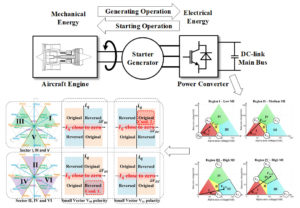A Modified Neutral Point Balancing Space Vector Modulation for Three-Level Neutral Point Clamped Converters in High-Speed Drives
Authors: Chen Li; Tao Yang; Ponggorn Kulsangcharoen; Giovanni Lo Calzo; Serhiy Bozhko; Christopher Gerada; Patrick Wheeler
Extended Abstract:
Since the beginning of the More Electric Aircraft (MEA) concept an increasing number of hydraulic, pneumatic and mechanical aircraft functional systems have been considered for replacement by electrical systems to improve fuel efficiency and to reduce emissions. One of the key technologies for the MEA is the aircraft electrical starter generator (ESG) system which enables starting aircraft engine electrically and using the engine to run a generator when the engine reaches a self-sustained speed. Earlier studies presented a novel 270Vdc, 45kVA, 32krpm integrated aircraft starter/generator system. This system consists of a high speed surface-mount permanent magnet synchronous machine and a three-level neutral-point-clamped (NPC) converter. During the engine start-up process, the ESG accelerates the engine shaft up to the ignition speed. In generation mode, the ESG extracts power from the engine shaft and supplies various onboard electrical loads through the three-level converter.
 This paper describes a high performance neutral-point voltage balancing space vector modulation technique for the three-level NPC converter within the proposed ESG system. Conventional three-level converter space vector modulation schemes do not function well under low power factor, low sample-time-ratio and near-unity modulation index operation conditions. These conditions are essentially dominate operation conditions for the converter in the proposed ESG system. To guarantee the ESG delivers satisfactory performances under such conditions, the proposed space vector modulation technique made a few modifications from the original space vector modulation technique. The selection of voltage space vectors is optimized for high modulation index and lower power factor condition. Disturbances induced by having a low sample-time-ratio is also evaluated and compensated. As a result, the proposed space vector modulation technique maintains the converter neutral-point voltage balance and ripple minimization over the full range of ESG operating conditions. In addition, the paper also provides a detailed analysis into the sources of three-level converter neutral-point voltage imbalances and ripples in high speed drives with deep flux weakening. Simulation results obtained from a Simulink/PLECS ESG system model and experimental results obtained from a fully validated 45kVA, 32krpm aircraft ESG test rig prove the proposed space vector modulation technique eliminates the neutral-point voltage imbalance and significantly reduces the neutral-point voltage ripple for the three-level converter in the ESG system.
This paper describes a high performance neutral-point voltage balancing space vector modulation technique for the three-level NPC converter within the proposed ESG system. Conventional three-level converter space vector modulation schemes do not function well under low power factor, low sample-time-ratio and near-unity modulation index operation conditions. These conditions are essentially dominate operation conditions for the converter in the proposed ESG system. To guarantee the ESG delivers satisfactory performances under such conditions, the proposed space vector modulation technique made a few modifications from the original space vector modulation technique. The selection of voltage space vectors is optimized for high modulation index and lower power factor condition. Disturbances induced by having a low sample-time-ratio is also evaluated and compensated. As a result, the proposed space vector modulation technique maintains the converter neutral-point voltage balance and ripple minimization over the full range of ESG operating conditions. In addition, the paper also provides a detailed analysis into the sources of three-level converter neutral-point voltage imbalances and ripples in high speed drives with deep flux weakening. Simulation results obtained from a Simulink/PLECS ESG system model and experimental results obtained from a fully validated 45kVA, 32krpm aircraft ESG test rig prove the proposed space vector modulation technique eliminates the neutral-point voltage imbalance and significantly reduces the neutral-point voltage ripple for the three-level converter in the ESG system.

